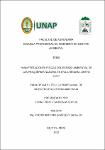| dc.contributor.advisor | Gratelly Silva, Pedro Antonio | |
| dc.contributor.author | Cardenas Soplin, Tonny Percy | |
| dc.date.accessioned | 2023-04-11T19:03:01Z | |
| dc.date.available | 2023-04-11T19:03:01Z | |
| dc.date.issued | 2022 | |
| dc.identifier.uri | https://hdl.handle.net/20.500.12737/8992 | |
| dc.description.abstract | The purpose of the thesis is the knowledge of the environmental state of the fishery from the physical manifestations of the landings of fish in Iquitos. It is a quantitative, correlational, non-experimental investigation, of the observational, analytical, retrospective type with the Data registered in the Regional Directorate of Production on the state of the fisheries in Loreto from 2010 to 2020. Descriptive statistics of central tendency and test were applied. Chi-square hypothesis.
The landing volume of fresh, dry-salted and fresh-salted fish species from 2010 to 2020 show decreasing landing variations year after year, apparently due to the reduction of populations in exploited fisheries in the region. In relation to the type of fish species, they have a decreasing trend line in the landing volume. The exception is found in the Paiche species, which increases its landing volume. Regarding the areas of origin of fish with the highest landing volume are Iquitos, Requena and Yurimaguas. As well as the intermediate landing volume areas are Contamana, Nauta and Caballo Cocha, which all tend to decrease significantly by 2020. In the intermediate volume group, the exception is the Caballo Cocha area, which has increased its volume in recent years. While in the areas of origin of the fish with the lowest landing volume are Pevas, the Strait and other areas. The area of the Strait and the other areas of origin show an increase in volume, in the first years of evaluation they have lower volumes, to later increase. Both areas of origin, despite the distance, present a growing trend line that has increased significantly in recent years. According to the Chi-square Test, the Null Hypothesis is rejected, which indicates that the state of the fisheries does not present environmental degradation; Therefore, the alternative hypothesis that mentions that the state of the fishery does present a degradation of the environmental state from the physical manifestations evaluated in the study is accepted. | en_US |
| dc.description.abstract | El propósito de la tesis es el conocimiento del estado ambiental de la pesquería a partir de las manifestaciones físicas de los desembarques de pescado en Iquitos. Es una investigación cuantitativa, correlacional, no experimental, del tipo observacional, analítico, retrospectivo con la Data registrada en la Dirección Regional de Producción sobre el estado de las pesquerías en Loreto del 2010 al 2020. Se aplicó estadística descriptiva de tendencia central y prueba de hipótesis de Chi cuadrado. El volumen de desembarque de las especies de pescado fresco, seco salado y fresco salado del 2010 al 2020, presenta variaciones decrecientes de desembarque año tras año, aparentemente por la reducción de las poblaciones en las pesquerías explotadas de la región. En relación al tipo de especies de pescado tienen una línea de tendencia decreciente en el volumen de desembarque. La excepción lo encontramos en la especie Paiche que incrementa su volumen de desembarque. Sobre las zonas de origen de pescado del mayor volumen de desembarque son Iquitos, Requena y Yurimaguas. Las zonas de volumen de desembarque intermedio son Contamana, Nauta y Caballo cocha que en todas tienden a disminuir significativamente al 2020. En el grupo de volumen intermedio la excepción es la zona de Caballo Cocha que se incrementa su volumen en los últimos años. Mientras que en las zonas de origen del pescado de menor volumen de desembarque son Pevas, el Estrecho y otras zonas. La zona del Estrecho y las otras zonas de origen muestran un incremento en el volumen, en los primeros años de evaluación tienen volúmenes menores, para luego incrementarse. Ambas zonas de origen a pesar de la distancia presentan una línea de tendencia creciente que se ha incrementado de manera importante en los últimos años. Según la Prueba de Chi cuadrado, se rechaza la Hipótesis Nula, que indica que el estado de las pesquerías no presenta degradación ambiental; por lo que se acepta la hipótesis alterna que menciona que el estado de la pesquería si presenta una degradación del estado ambiental a partir de las manifestaciones físicas evaluadas en el estudio. | es_PE |
| dc.format | application/pdf | es_PE |
| dc.language.iso | spa | es_PE |
| dc.publisher | Universidad Nacional de la Amazonía Peruana | es_PE |
| dc.rights | info:eu-repo/semantics/openAccess | * |
| dc.rights.uri | https://creativecommons.org/licenses/by/4.0/ | * |
| dc.subject | Factores ambientales | es_PE |
| dc.subject | Pesca artesanal | es_PE |
| dc.subject | Desembarque | es_PE |
| dc.subject | Contaminación | es_PE |
| dc.title | Manifestaciones físicas del estado ambiental de las pesquerías naturales en la región Loreto 2022 | es_PE |
| dc.type | info:eu-repo/semantics/bachelorThesis | es_PE |
| thesis.degree.discipline | Ingeniería en Gestión Ambiental | es_PE |
| thesis.degree.grantor | Universidad Nacional de la Amazonía Peruana. Facultad de Agronomía | es_PE |
| thesis.degree.name | Ingeniero(a) en Gestión Ambiental | es_PE |
| dc.subject.ocde | https://purl.org/pe-repo/ocde/ford#5.07.01 | es_PE |
| renati.author.dni | 43645719 | |
| renati.advisor.orcid | https://orcid.org/0000-0002-1708-7101 | |
| renati.advisor.dni | 05220057 | |
| renati.type | https://purl.org/pe-repo/renati/type#tesis | es_PE |
| renati.discipline | 521236 | es_PE |
| renati.level | https://purl.org/pe-repo/renati/level#tituloProfesional | es_PE |
| renati.juror | Flores Malaverry, Jorge Agustin | |
| renati.juror | Avila Fucos, Manuel Calixto | |
| renati.juror | Machuca Espinar, Giorly Geovanni | |
| dc.publisher.country | PE | es_PE |





